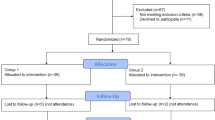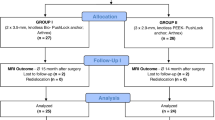Abstract
Purpose
To compare rates of recurrent instability, revision surgery and functional outcomes following arthroscopic anterior capsulolabral repair for recurrent anterior instability using knot-tying versus knotless suture anchor techniques.
Methods
Patients who had undergone arthroscopic anterior labrum and capsular repair for recurrent anterior glenohumeral instability using knotless anchors were identified. Those with minimum 2-year follow-up were matched (1:2) to knot-tying anchor repair patients. Rates of failure and recurrent instability were compared, as well as Visual Analog Scale (VAS), Single Assessment Numeric Evaluation (SANE), Quick Disabilities of the Arm, Shoulder and Hand (QuickDASH), University of California Los Angeles (UCLA) and Rowe scores.
Results
One hundred and two patients (89 males, 13 females) with a mean age of 24.3 ± 9.6 were included. Repair was performed with knotless anchors in 34 and knot-tying anchors in 68 shoulders. At mean follow-up of 4.8 ± 2.5 years, re-dislocation rates between groups were not significantly different (knotless anchor: 9% versus knot-tying group: 15%, n.s.), but the knot-tying group showed a higher re-subluxation rate (p = 0.039). 12 (18%) revisions were performed in the knot-tying group at a mean 2.9 years after surgery and 1 (3%) revision in the knotless anchors group at 1.4 years (n.s.). There was no difference in mean VAS with use (1.3 ± 1.9 versus 0.8 ± 1.5, n.s.), SANE scores (91.8 ± 12.7 versus 92.0 ± 11.0, n.s.), QuickDASH scores (4.1 ± 5.5 versus 3.0 ± 6.5, n.s.), UCLA Shoulder Score (32.5 ± 3.6 versus 33.2 ± 3.1, n.s.), or Rowe scores (90.5 ± 18.5 versus 92.2 ± 16.6, n.s.) between knotless and knot-tying groups, respectively. VAS at rest was higher in the knotless group (0.7 ± 1.5 vs 0.1 ± 0.4, p = 0.021).
Conclusions
Knotless anchors demonstrated similar rates of re-dislocation and revision surgery, and lower rates of recurrent subluxation, compared to knot-tying anchors. Patients achieved good-to-excellent functional outcomes. This supports the efficacy of knotless anchors as an alternative to knot-tying anchors for arthroscopic anterior labral repair of recurrent anterior shoulder dislocation.
Level of evidence
III.


Similar content being viewed by others
References
Amstutz HC, Sew AH, Clarke IC (1981) UCLA anatomic total shoulder arthroplasty. Clin Orthop Relat Res 155:7–20
Aydin N, Unal MB, Asansu M, Tok O (2017) Concomitant SLAP repair does not influence the surgical outcome for arthroscopic Bankart repair of traumatic shoulder dislocations. J Orthop Surg (Hong Kong) 25:2309499017718952
Beaton DE, Wright JG, Katz JN (2005) Development of the QuickDASH: comparison of three item-reduction approaches. J Bone Jt Surg Am 87:1038–1046
Brown L, Rothermel S, Joshi R, Dhawan A (2017) Recurrent instability after arthroscopic Bankart reconstruction: a systematic review of surgical technical factors. Arthroscopy 33:2081–2092
Castagna A, Markopoulos N, Conti M, Delle Rose G, Papadakou E, Garofalo R (2010) Arthroscopic Bankart suture-anchor repair: radiological and clinical outcome at minimum 10 years of follow-up. Am J Sports Med 38:2012–2016
Cho NS, Lubis AM, Ha JH, Rhee YG (2006) Clinical results of arthroscopic Bankart repair with knot-tying and knotless suture anchors. Arthroscopy 22:1276–1282
Faul F, Erdfelder E, Buchner A, Lang AG (2009) Statistical power analyses using G*Power 3.1: tests for correlation and regression analyses. Behav Res Methods 41:1149–1160
Faul F, Erdfelder E, Lang AG, Buchner A (2007) G*Power 3: a flexible statistical power analysis program for the social, behavioral, and biomedical sciences. Behav Res Methods 39:175–191
Feng S, Song Y, Li H, Chen J, Chen S (2019) Outcomes for arthroscopic repair of combined Bankart/SLAP lesions in the treatment of anterior shoulder instability: a systematic review and meta-analysis. Orthop J Sports Med 7:2325967119877804
Hayashida K, Yoneda M, Mizuno N, Fukushima S, Nakagawa S (2006) Arthroscopic Bankart repair with knotless suture anchor for traumatic anterior shoulder instability: results of short-term follow-up. Arthroscopy 22:620–626
Hudak PL, Amadio PC, Bombardier C (1996) Development of an upper extremity outcome measure: the DASH (disabilities of the arm, shoulder and hand) [corrected]. The Upper Extremity Collaborative Group (UECG). Am J Ind Med 29:602–608
Kocaoglu B, Guven O, Nalbantoglu U, Aydin N, Haklar U (2009) No difference between knotless sutures and suture anchors in arthroscopic repair of Bankart lesions in collision athletes. Knee Surg Sports Traumatol Arthrosc 17:844–849
Komnos GA, Banios K, Liantsis A, Alexiou K, Varitimidis S, Bareka M et al (2019) Results of arthroscopic bankart repair in recreational athletes and laborers: a retrospective study with 5–14 years of follow-up. Orthop J Sports Med 7:2325967119881648
Krych AJ, Sousa PL, King AH, Morgan JA, May JH, Dahm DL (2015) The effect of cartilage injury after arthroscopic stabilization for shoulder instability. Orthopedics 38:e965–e969
Lacheta L, Dekker TJ, Anderson N, Goldenberg B, Millett PJ (2019) Arthroscopic knotless, tensionable all-suture anchor bankart repair. Arthrosc Tech 8(6):e647–e653. https://doi.org/10.1016/j.eats.2019.02.010
Langley GB, Sheppeard H (1985) The visual analogue scale: its use in pain measurement. Rheumatol Int 5:145–148
Leroux T, Wasserstein D, Veillette C, Khoshbin A, Henry P, Chahal J et al (2014) Epidemiology of primary anterior shoulder dislocation requiring closed reduction in Ontario, Canada. Am J Sports Med 42:442–450
Ng DZ, Kumar VP (2014) Arthroscopic Bankart repair using knot-tying versus knotless suture anchors: is there a difference? Arthroscopy 30:422–427
Nho SJ, Frank RM, Thiel GSV, Wang FC, Wang VM, Provencher MT et al (2010) A biomechanical analysis of anterior Bankart repair using suture anchors. Am J Sports Med 38:1405–1412
Owens BD, Harrast JJ, Hurwitz SR, Thompson TL, Wolf JM (2011) Surgical trends in Bankart repair: an analysis of data from the American Board of Orthopaedic Surgery certification examination. Am J Sports Med 39:1865–1869
Ranawat AS, Golish SR, Miller MD, Caldwell PE 3rd, Singanamala N, Treme G et al (2011) Modes of failure of knotted and knotless suture anchors in an arthroscopic Bankart repair model with the capsulolabral tissues intact. Am J Orthop (Belle Mead NJ) 40:134–138
Rowe CR, Patel D, Southmayd WW (1978) The Bankart procedure: a long-term end-result study. J Bone Jt Surg Am 60:1–16
Saier T, Plath JE, Waibel S, Minzlaff P, Feucht MJ, Herschbach P et al (2017) How satisfied are patients with arthroscopic Bankart repair? A 2-year follow-up on quality-of-life outcome. Arthroscopy 33:1777–1785
Streubel PN, Krych AJ, Simone JP, Dahm DL, Sperling JW, Steinmann SP et al (2014) Anterior glenohumeral instability: a pathology-based surgical treatment strategy. J Am Acad Orthop Surg 22:283–294
Tashjian RZ, Deloach J, Porucznik CA, Powell AP (2009) Minimal clinically important differences (MCID) and patient acceptable symptomatic state (PASS) for Visual Analog Scales (VAS) measuring pain in patients treated for rotator cuff disease. J Shoulder Elb Surg 18:927–932
Tashjian RZ, Hung M, Keener JD, Bowen RC, McAllister J, Chen W et al (2017) Determining the minimal clinically important difference for the American Shoulder and Elbow Surgeons score, Simple Shoulder Test, and Visual Analog Scale (VAS) measuring pain after shoulder arthroplasty. J Shoulder Elb Surg 26:144–148
Thigpen CA, Shanley E, Momaya AM, Kissenberth MJ, Tolan SJ, Tokish JM, Hawkins RJ (2018) Validity and responsiveness of the single alpha-numeric evaluation for shoulder patients. Am J Sports Med 46(14):3480–3485. https://doi.org/10.1177/0363546518807924
Williams GN, Gangel TJ, Arciero RA, Uhorchak JM, Taylor DC (1999) Comparison of the single assessment numeric evaluation method and two shoulder rating scales. Outcomes measures after shoulder surgery. Am J Sports Med 27:214–221
Yapp LZ, Nicholson JA, Robinson CM (2020) Primary arthroscopic stabilization for a first-time anterior dislocation of the shoulder: long-term follow-up of a randomized, double-blinded trial. J Bone Jt Surg Am 102:460–467
Zacchilli MA, Owens BD (2010) Epidemiology of shoulder dislocations presenting to emergency departments in the United States. J Bone Jt Surg Am 92:542–549
Author information
Authors and Affiliations
Contributions
All eight authors listed on this manuscript met the ICMJE criteria for authorship as follows: substantial contributions to the conception or design of the work; or the acquisition, analysis, or interpretation of data for the work; drafting the work or revising it critically for important intellectual content; final approval of the version to be published; agreement to be accountable for all aspects of the work in ensuring that questions related to the accuracy or integrity of any part of the work are appropriately investigated and resolved. Specifically: ITW: data curation; formal analysis; investigation; methodology; validation; writing—original draft; writing—review and editing, VSD: data curation; formal analysis; investigation; methodology; validation; writing—original draft; writing—review and editing, DRM: data curation; formal analysis; investigation; methodology; project administration; resources; validation; writing—review and editing, CLC: conceptualization; formal analysis; investigation; methodology; resources; supervision; validation; writing—review and editing, JDB: formal analysis; investigation; methodology; resources; supervision; validation; writing—review and editing, JSS: formal analysis; methodology; project administration; resources; supervision; validation; writing—review and editing, DLD: conceptualization; formal analysis; methodology; project administration; resources; supervision; validation; writing—review and editing, AJK: conceptualization; formal analysis; investigation; methodology; project administration; resources; supervision; validation; writing—original draft; writing—review and editing.
Corresponding author
Ethics declarations
Conflict of interest
I.T.W., V.S.D, D.R.M., and C.L.C. have no disclosures. J.D.B. is a paid consultant for Stryker. J.S. is a paid consultant for Wright Medical Technology and Exactech; editorial board member for Journal of Orthopaedics and Traumatology, Journal of Shoulder and Elbow Arthroplasty, and Journal of Shoulder and Elbow Surgery; board or committee member of American Shoulder and Elbow Surgeons and Acumed; receives publishing royalties, financial or material support from Journal of Shoulder and Elbow Surgery, Elsevier, and Oxford University Press; IP royalties from Stryker; and is a paid presenter for Acumed, Styker, and Wright Medical Technology. D.L.D. is a board or committee member of American Orthopaedic Society for Sports Medicine and NBA/GE Strategic Advisory Board; receives research support from Arthrex, Inc; and spouse owns stock or stock options and receives royalties from Tenex Health, Inc and Sonex Health, LLC. A.J.K. is a paid consultant for Arthrex, JRF Ortho, and Vericel; board or committee member of International Cartilage Repair Society, International Society of Arthroscopy, Knee Surgery, and Orthopaedic Sports Medicine, Minnesota Orthopedic Society, and Musculoskeletal Transplantation Foundation; editorial or governing board member of American Journal of Sports Medicine; and receives research support from Aesculap/B.Braun, Arthrex, Arthritis Foundation, Ceterix, and Histogenics.
Funding
No external or internal funding was used for this investigation.
Ethical approval
The study was approved by the Institutional Review Board.
Additional information
Publisher's Note
Springer Nature remains neutral with regard to jurisdictional claims in published maps and institutional affiliations.
Rights and permissions
About this article
Cite this article
Wu, I.T., Desai, V.S., Mangold, D.R. et al. Comparable clinical outcomes using knotless and knot-tying anchors for arthroscopic capsulolabral repair in recurrent anterior glenohumeral instability at mean 5-year follow-up. Knee Surg Sports Traumatol Arthrosc 29, 2077–2084 (2021). https://doi.org/10.1007/s00167-020-06057-7
Received:
Accepted:
Published:
Issue Date:
DOI: https://doi.org/10.1007/s00167-020-06057-7




